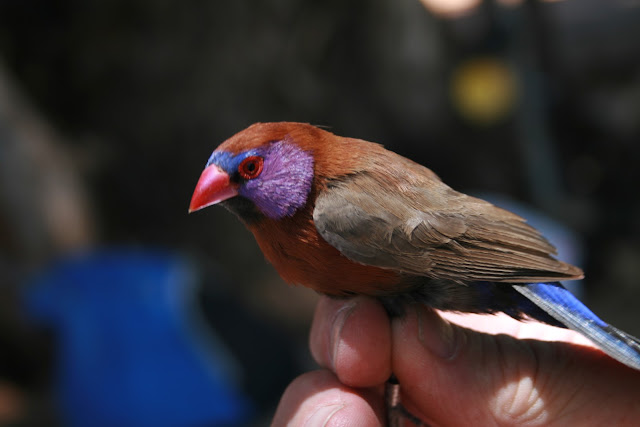 |
| Adult sociable weaver. Sex can't be identified in the field and we have to use genetics to identify the sex of the weavers.[Photo by Gavin Leighton] |
Avian biology and behavior have contributed much to our
understanding of social behaviors.
The natural world is rife with prosocial behaviors, despite the tendency
for natural selection to promote selfish individuals. An especially intriguing
case of cooperative behavior is displayed by Sociable Weavers (Philetairus socius). These small birds (~30g) live in semi-arid
savannah in southwestern Africa; but what sets these small passerines apart is
that they live in colonies that build and maintain perennial, communal nests
(See below). Interestingly, several other species of birds such as Pygmy Falcons, Rosy-faced Lovebirds, and Scaly-feathered Finches have been known to
roost in the empty chambers of Sociable Weaver nests.
 |
| Sociable weaver colony. At the colony we trapped 108 birds. [Photo by Gavin Leighton] |
The communal nest also presents an opportunity to understand
the evolution of cooperative behaviors that maintain communal goods.
Theoretically, Sociable Weavers that
exploit the nest-building behavior of other weavers should be selectively
favored, therefore increasing selfishness.
In contrast, such selfishness is avoided, and I am
interested in delimiting the evolutionary mechanisms that maintain cooperative
nest construction in Sociable Weavers.
 |
| These are two rosy-faced lovebirds, one of the species of parrots in Namibia. Common in the Khomas region, they are known to hang around sociable weaver nests and in some cases even roost in the chambers of a sociable weaver nest. [Photo by Gavin Leighton] |
One possible mechanism that may maintain cooperative nest
construction is kin selection. Kin
selection supports cooperative behaviors by allowing cooperative individuals to
spread their genes by helping relatives reproduce, who share genes with the
actor due to common ancestry. To
delineate the relatedness of Sociable Weaver colonies, I recently visited
Namibia to collect blood samples from Sociable Weavers. The weavers are trapped en masse in the
morning and it often requires multiple individuals to quickly remove all the
birds. I removed blood from the
trapped individuals and will be performing genetic analyses to see if the nests
are composed of extended family groups.
To complete the work, I was helped by multiple individuals
from the local city.
Most of the
individuals that helped with the projects were Namibian ornithologists in the
region, and most of these individuals are birders by passion and have a career
in a field other than avian biology.
This is probably the most salient difference between birders in the US
and Namibia.
In the US, most bird
banding is conducted at designated banding stations, whereas in Namibia banding
is performed by a dedicated group of individuals who band on the weekends and
in back yards.
 |
| Ostrich. The red on the lower shins is indicative that this individual is in breeding condition. [Photo by Gavin Leighton] |
Such banding is critical to the success of Namibian
ornithology, as there are no dedicated banding stations or dedicated
ornithologists at the universities.
Due to the lack of research in the country, much of the bird life in the
region is still shrouded in mystery.
As an example, Ludwig’s bustard is endemic to the region, but only one
individual has ever been banded, and its behavior and breeding tendencies are
almost completely unknown.
The
landscape is entirely wide open, and the density of birds reflects the pristine
habitat; in one day we found a nest of Secretary Birds 200 meters away from a
nest of Lappet-faced Vultures.
Namibia also offers diverse habitats for birds and birders; from coastal
regions to two deserts, birds of all types inhabit the land of Namibia.
 |
| Yellow Canary. [Photo by Gavin Leighton] |
 |
| Purple-cheeked waxbill. Common in the region. [Photo by Gavin Leighton] |
 |
| Scaly-feathered finch. Like Rosy-faced lovebirds, Scale-feathered finches are known to join sociable weaver feeding flocks and are also reported to roost in the chambers of sociable weaver nests. [Photo by Gavin Leighton] | |
By Gavin Leighton








No comments:
Post a Comment